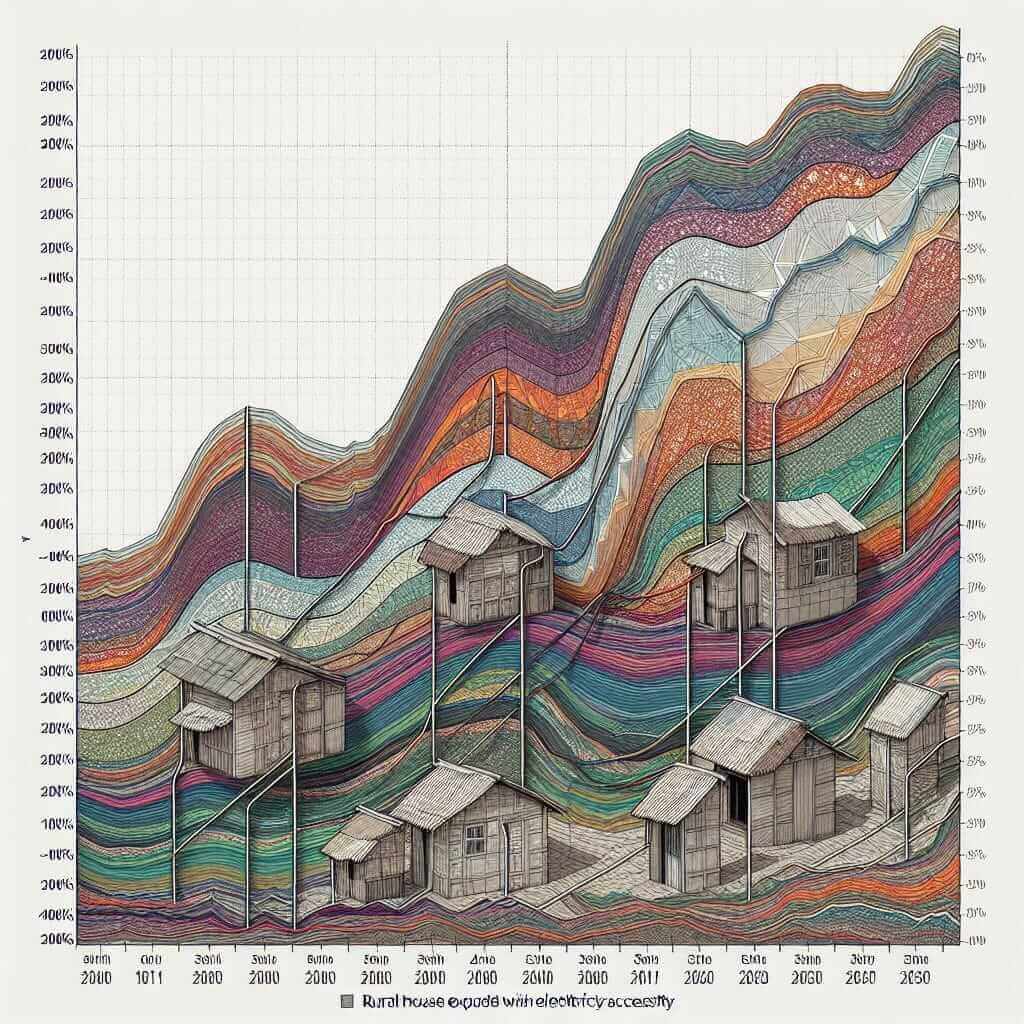“Electricity access in rural areas” is a topic frequently appearing in IELTS Writing Task 1, requiring test-takers to analyze and describe visual data, often in the form of line graphs, bar charts, or tables. This essay will provide a comprehensive guide to tackling this topic, equipping you with the necessary skills and vocabulary to achieve a Band 7+ score.
Table Of Contents
We’ll analyze a sample question, delve into structuring your response, explore essential vocabulary, and provide a model answer to illustrate these principles.
Sample IELTS Writing Task 1 Question
You should spend about 20 minutes on this task.
The chart below shows the percentage of rural households with access to electricity in different regions of the world between 2000 and 2020.
Summarize the information by selecting and reporting the main features, and make comparisons where relevant.
(Insert a table or chart here depicting the percentage of rural households with access to electricity in different regions of the world between 2000 and 2020).

Data Analysis and Interpretation
Before writing, carefully analyze the provided data:
- Identify the type of visual: Is it a line graph, bar chart, table, or a combination?
- Understand the axes: What variables are being measured? What are the units of measurement?
- Highlight key trends: Are there any noticeable increases, decreases, or fluctuations?
- Identify significant comparisons: How do the different regions compare to each other?
Writing the Introduction
Begin by paraphrasing the question to demonstrate your understanding. For instance:
- “The provided chart illustrates the proportion of rural homes globally that had access to electricity over a two-decade period, from 2000 to 2020.”
Describing the Main Features
Focus on the most significant changes and trends. Use specific data points from the visual to support your claims. For example:
- “Globally, there was a considerable increase in the percentage of rural households with electricity access. This figure rose from approximately (insert starting percentage from the data) in 2000 to around (insert final percentage from the data) in 2020.”
Making Comparisons
Draw comparisons between different regions or time periods. Utilize comparative language for clarity:
- “South Asia witnessed the most dramatic growth in rural electrification, with the percentage of households having access to electricity more than doubling over the two decades.”
- “In contrast, Sub-Saharan Africa, despite experiencing some improvement, continued to lag behind other regions in terms of rural electrification rates.”
Vocabulary Enhancement
Employ a diverse range of vocabulary to showcase your language proficiency:
- Instead of “increase,” use: surge, rise, climb, escalation, uptick
- Instead of “decrease,” use: decline, fall, drop, reduction, downturn
- For comparison: whereas, while, in contrast, conversely, on the other hand
Grammar Essentials
Use appropriate grammatical structures to convey information accurately:
- Prepositions: Be mindful of prepositions when describing trends (e.g., “an increase in, a decrease from“).
- Tenses: Use the past tense to describe past trends and the present tense for general statements about the data.
- Comparatives and Superlatives: Use comparative and superlative adjectives to highlight differences and similarities between data points.
Model Answer (Approximately 170 words)
The provided chart illustrates the proportion of rural homes globally that had access to electricity over a two-decade period, from 2000 to 2020.
Overall, there was a significant rise in rural electrification worldwide. In 2000, just over half of rural households had access to electricity. However, by 2020, this figure surged to approximately 80%, indicating substantial progress in expanding electricity access.
Regionally, South Asia experienced the most dramatic transformation. The percentage of rural households with electricity more than doubled, climbing from around 30% to over 75%. Similarly, East Asia and Southeast Asia witnessed considerable improvements, with rates surpassing 95% by 2020. In contrast, Sub-Saharan Africa, despite experiencing some progress, continued to lag behind other regions. The proportion of rural homes with electricity access in this region remained below 50% in 2020.
Key Vocabulary
- Proportion (noun): /prəˈpɔːʃən/ – A part, share, or number considered in comparative relation to a whole.
- Surge (verb): /sɜːrdʒ/ – To increase suddenly and powerfully.
- Transformation (noun): /ˌtræns.fɔːrˈmeɪ.ʃən/ – A complete change in the appearance or character of something or someone.
- Lag behind (phrasal verb): /læɡ bɪˈhaɪnd/ – To make slower progress than others and be left behind.
- Substantial (adjective): /səbˈstæn.ʃəl/ – Large in size, value, or importance.
Conclusion
Mastering the art of describing visual data related to “electricity access in rural areas” is crucial for success in IELTS Writing Task 1. By understanding the data, employing appropriate vocabulary and grammar, and structuring your response effectively, you can confidently tackle this topic and achieve a Band 7+ score. Remember to practice regularly and analyze model answers to further enhance your skills.